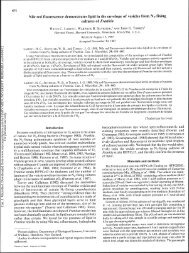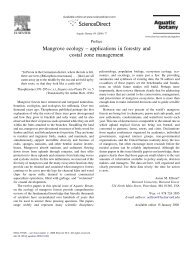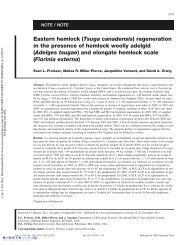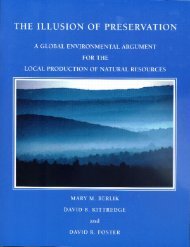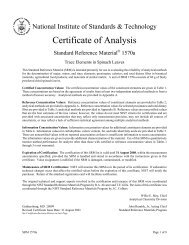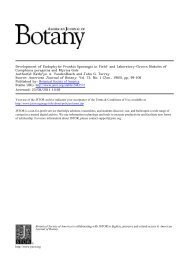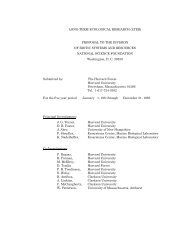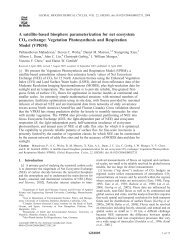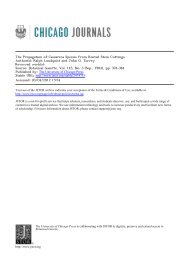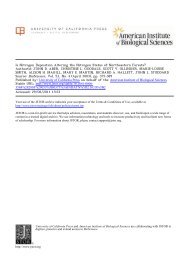Abstracts of Papers - Harvard Forest - Harvard University
Abstracts of Papers - Harvard Forest - Harvard University
Abstracts of Papers - Harvard Forest - Harvard University
Create successful ePaper yourself
Turn your PDF publications into a flip-book with our unique Google optimized e-Paper software.
Parthenium argentatum, Gray (guayule), a north Amer-<br />
ican desert shrub, contains large quantities <strong>of</strong> high<br />
quality rubber. Unlike Hevea, P. argentatum stores<br />
rubber within parenchymatous cells. The first<br />
appearance <strong>of</strong> rubber occurs in the epithelial cells<br />
<strong>of</strong> the primary and secondary resin canals <strong>of</strong> six to<br />
eight month old plants. The morphology <strong>of</strong> these<br />
resin canals has been previously described. Bio-<br />
regulators, such as 2-(3,4-dichlorophenoxy)-triethyl-<br />
amine (DCPTA), are known to increase the total rubber<br />
content <strong>of</strong> P. argentatum. Experimental P. argentatum<br />
plants were treated by spraying with a solution <strong>of</strong><br />
50 ppm DCPTA and 250 ppm Ortho X-77 (a wetting agent)<br />
while control plants were sprayed with the Ortho X-77<br />
only. An analysis was made <strong>of</strong> the effects <strong>of</strong> these<br />
treatments on resin canal morphology, including resin<br />
canal number and size and epithelial cell number and<br />
size.<br />
WILDER, GEORGE J.* and PHILIP B. TOMLINSON.<br />
<strong>Harvard</strong> <strong>Forest</strong>, <strong>Harvard</strong> <strong>University</strong>,<br />
- Functional and systematic-anatomical<br />
Petersham,<br />
studies<br />
MA.<br />
<strong>of</strong><br />
laminae <strong>of</strong> the Cyclanthaceae. I. Epidermis.<br />
Cyclanthaceous laminae are normally hypostomatic and<br />
their abaxial epidermis tends to exhibit longitudinal<br />
bands either with or without stomata. In the subfamily<br />
Carludovicoideae bands <strong>of</strong> the abaxial epidermis<br />
without stomata develop over fiber bundles, abaxial<br />
ridges, and sometimes veins; bands <strong>of</strong> epidermal expansion<br />
cells, also without stomata, occur in each<br />
epidermis above or below adaxial and abaxial ridges,<br />
and over expansion tissue <strong>of</strong> the mesophyll. Stomata<br />
are either functional or nonfunctional. The pore <strong>of</strong><br />
a functional stomate extends between inner and outer<br />
ledges <strong>of</strong> the guard cells, and consists <strong>of</strong> a one or<br />
two-chambered front cavity, back cavity, and central<br />
pore. Both guard cells <strong>of</strong> a stomate may be connected<br />
by two obvious polar perforations. Nonfunctional<br />
stomata exhibit collapsed guard cells with or without<br />
lignified walls, and sometimes also have substomatal<br />
chambers occluded by the abnormal enlargement <strong>of</strong> adjacent<br />
cells, e.g. subsidiary cells. Subsidiary<br />
cells and undifferentiated epidermal cells may overlap<br />
one another in ways that appear mechanically advantageous.<br />
Each stomate is typically associated<br />
with fo'ur subsidiary cells which may differ from undifferentiated<br />
epidermal cells according to position,<br />
shape, non-nuclear contents, nuclear size, cuticular<br />
ornamentation, and cell walls. In each subfamily epidermal<br />
cells proper may exhibit lumen papillae and<br />
also cuticular ornamentation (papillae, ridges). An<br />
epidermis sometimes has substantial dorsiventral symmetry.<br />
In addition, one can sometimes determine (a)<br />
whether a noncostal fragment <strong>of</strong> epidermis belonged to<br />
the abaxial or adaxial leaf surface, (b) what types <strong>of</strong><br />
cells or structures it occurred over, (c) which are<br />
its proximal or distal ends and, hence, (d) its right<br />
and left sides. Systematic conclusions w'll be given.<br />
WILDER, GEORGE J.* and PHILIP B. TOMLINSON.<br />
<strong>Harvard</strong> <strong>Forest</strong>,<br />
01366.<br />
<strong>Harvard</strong> <strong>University</strong>, Petersham, MA<br />
- Functional and systematic-anatomical studies <strong>of</strong><br />
laminae<br />
veins.<br />
<strong>of</strong> the Cyclanthaceae. II. Mesophyll and<br />
The mesophyll contains hypodermal cells, bundle<br />
sheath cells, epithelial cells <strong>of</strong> mucilage cavities<br />
(certain Garludovicoideae), and laticifer sheaths<br />
(Cyclanthus), which exhibit common features and,<br />
hence, are categorized together as "boundary layers"<br />
The remaining cells <strong>of</strong> the mesophyll between boundary<br />
Developmental and Structural Section 35<br />
layers comprise adaxial, abaxial, and sometimes mid-<br />
dle regions. Depending on the species, ordinary pa-<br />
renchymacells between boundary layers are either mono-<br />
morphic or dimorphic; where dimorphic, one <strong>of</strong> the two<br />
types - generally, with larger and more concentrated<br />
chloroplasts - is interpreted as more specialized for<br />
photosynthesis. Within ordinary parenchyma cells,<br />
tannin or tannin-like material may comprise very ela-<br />
borate star figures which are refractile in preserved<br />
material. In certain species <strong>of</strong> Carludovicoideae the<br />
mesophyll contains thin-walled dead cells, and pres-<br />
ence <strong>of</strong> these cells is <strong>of</strong> particular interest because<br />
<strong>of</strong> the occurrence <strong>of</strong> lysigenous intercellular spaces<br />
in Cyclanthus. Fibers <strong>of</strong> the mesophyll tend to differ<br />
from phloem fibers in ways which suggest that these<br />
two cell types are specialized to contribute tensile<br />
strength and rigidity, respectively. Raphide sacs<br />
and sometimes also styloid sacs occur, and what may<br />
superficially appear as one raphide is <strong>of</strong>ten com-<br />
pound, comprised <strong>of</strong> four or more.subunits. Veins <strong>of</strong><br />
an inter-ridge area (Carludovicoideae) or between<br />
principal veins (Cyclanthus) are <strong>of</strong> different orders<br />
<strong>of</strong> diameter, and vein number increases exponentially<br />
in increasingly higher orders. The smallest sieve<br />
elements in a vein tend to be gro5uped into one or two<br />
poles on the adaxial side <strong>of</strong> the phloem. Systematic<br />
conclusions will be presented.<br />
WISNIEWSKI, MICHAEL*, A. LINN BOGLE and C.L. WILSON<br />
Department <strong>of</strong> Botany and Plant Pathology, <strong>University</strong><br />
<strong>of</strong> New Hampshire, Durham, 03824. Appalachian Fruit<br />
Research Station, USDA, Kearneysville, WV 25430 -<br />
The Developmental Anatorny <strong>of</strong> Wound Response in<br />
Current Year Shoots <strong>of</strong> Prunus persica L. Batsch.<br />
The ability <strong>of</strong> peach trees to effectively compart-<br />
mentalize wounds may play an important role in resis-<br />
tance to Cytospora canker. Little information exists<br />
in this area for peach. Therefore, an anatomical in-<br />
vestigation <strong>of</strong> wound response was undertaken. Current<br />
year shoots <strong>of</strong> three cultivars were wounded by making<br />
a scratch with a fine forceps. Samples were collected<br />
periodically and examined using light microscopy and<br />
SEM. Initial wounding penetrated into the cortec and<br />
occasionally to the vascular cambium. Within two<br />
weeks, a well differentiated wound periderm was es-<br />
tablished from undifferentiated phloem and cortical<br />
cells. Normal xylem and phloem production was replac-<br />
ed in a wide area <strong>of</strong> the stem by parenchymatous tissue.<br />
These cells became hypertrophied and in some areas<br />
degenerated and formed gum cysts. Phellem cells pro-<br />
duced by the wound periderm became quickly and heavily<br />
suberized in contrast to normal epidermal cells. A<br />
region exhibiting strong aut<strong>of</strong>luorescence was observ-<br />
ed at the radial edge <strong>of</strong> the wound periderm. Within<br />
four weeks, periderm formation was initiated in un-<br />
injured portions <strong>of</strong> the stem (i.e,, the wound peri-<br />
derm acted as a center for and instigated premature<br />
periderm development in the rest <strong>of</strong> the stem). There<br />
was also an accumulation <strong>of</strong> druses in the cortical<br />
cells <strong>of</strong> the wound area. An EDXA <strong>of</strong> these crystals<br />
identified the presence <strong>of</strong> calcium. No major differ-<br />
ences between cultivars were observed. Observations<br />
indicate that periderm formation occurs at a relative-<br />
ly fast rate compared to rates reported for other<br />
species and that the degree <strong>of</strong> gum cyst or gum dUCt<br />
formation is proportional to the severity <strong>of</strong> the wound.<br />
WITTLER, GEORGE H.* and JAMES D. MAUSETH. Department<br />
<strong>of</strong> Botany, <strong>University</strong> <strong>of</strong> Texas, Austin, TX<br />
78712. - The ultrastructure <strong>of</strong> developing<br />
ducts i n Mammill 1ari a heyderi ( Cactaceae )<br />
Electron microscopy was used to investigate<br />
latex<br />
early




